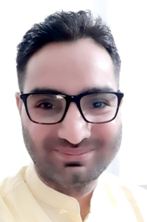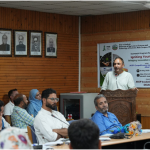WORLD STROKE DAY
Stroke is one of the leading causes of death and disability in India. The estimated prevalence of stroke range from 84 to 262 per 100,000 in rural and 334 to 424 per 100,000 population in urban areas. Based on the recent population – based studies the incidence rate of stroke range from 119 to 145 per 100,000 population.
A stroke is sudden reduction of blood supply to brain tissue due to blockage of a blood vessel or sudden rupture of a brain blood vessel. In both cases brain tissue is deprived of oxygen and nutrients and hence begins to die. We lose nearly two million neurons every minute after stroke. So stroke is a medical emergency that needs prompt treat and early action to minimize the damage and potential complications.
Talking about the signs and symptoms, a stroke can present in different ways. Common sign and symptoms include — sudden onset trouble with speaking and understanding. One may experience confusion. One’s speech may be slurred or there can be difficulty in understanding speech. Sudden onset weakness or numbness of the face, arm or legs. This often happens just on one side of the body.
Sudden onset trouble with seeing in one or both eyes. One may suddenly have blurred or blackened vision in one or both eyes, or you may see double. Sudden severe headache which may be accompanied by vomiting, dizziness or altered consciousness. Sudden onset walking difficulty. One may stumble or experience sudden dizziness, loss of balance or loss of coordination. One should note that these things happen SUDDENLY.
There is an acronym to remember “BE FAST” that stands for BALANCE, EYE, FACE, ARMS, SPEECH & TIME. One should keep in mind this acronym that will help to detect stroke at the earliest. BALANCE – Is there a sudden loss of balance or coordination?
EYES – Is there sudden double vision or blurring of vision?
FACE – Ask the person to smile. Is one or both sides of the face drooping?
ARMS – Ask the person to raise both arms. Does one side drift downward? Is there weakness or numbness on one side?
SPEECH – Does the person have slurred speech or loss of speech?
TIME – Call for immediate medical attention if you note any of these signs. Every minute counts. The longer a stroke goes untreated, the greater the potential for brain damage and disability. Remember “TIME IS BRAIN, each minute costs two million neurons.
Focusing on the causes of a stroke, it may be caused by a blocked artery (ischemic stroke) or the rupture of a blood vessel (hemorrhagic stroke). Some people may experience only a temporary disruption of blood flow to the brain (transient ischemic attack, or TIA) that doesn’t cause permanent damage.
Ischemic stroke is the most common type of stroke, about 80 percent of strokes are ischemic in nature. It happens when the arteries to the brain become narrowed or blocked, causing severely reduced blood flow (ischemia). The most common ischemic strokes include:
Thrombotic stroke: A thrombotic stroke occurs when a blood clot (thrombus) forms in one of the arteries that supply blood to your brain. A clot may be caused by fatty deposits (plaque) that build up in arteries and cause reduction in blood flow (atherosclerosis).
Embolic stroke: An embolic stroke occurs when a blood clot or other debris forms away from your brain — commonly in your heart — and is swept through your bloodstream to lodge in narrower brain arteries. This type of blood clot is called an embolus.
Hemorrhagic stroke occurs when a blood vessel in your brain leaks or ruptures. Brain haemorrhages can result from many conditions that affect your blood vessels. Types of hemorrhagic stroke include:
Intracerebral haemorrhage — in an intracerebral haemorrhage, a blood vessel in the brain bursts and spills into the surrounding brain tissue, damaging brain cells. Brain cells beyond the leak are deprived of blood and are also damaged. High blood pressure, trauma, vascular malformations, use of blood-thinning medications, weak spots in blood vessels (aneurysms) and other conditions may cause an intracerebral haemorrhage.
Subarachnoid haemorrhage –in a subarachnoid haemorrhage, an artery bursts and spills blood into the space between the surface of your brain and its covering membranes. This bleeding is often signalled by a sudden, severe headache with or without loss of consciousness.
A transient ischemic attack (TIA) — sometimes known as a mini-stroke –temporary decrease in blood supply to part of one’s brain causes TIAs, which may last as little as few seconds to an hour. Like an ischemic stroke, a TIA occurs when a clot or debris blocks blood flow to part of one’s nervous system — but there is no permanent tissue damage and no lasting symptoms.
Risk Factors
Potentially treatable stroke risk factors include:
Lifestyle risk factors:
- Being overweight or obese
- Physical inactivity
- Heavy or binge drinking
- Use of illicit drugs such as cocaine and methamphetamines
Medical risk factors:
- High blood pressure
- Cigarette smoking or exposure to second-hand smoke
- High cholesterol
- Diabetes
Obstructive sleep apnoea
Cardiovascular diseases — including heart failure, heart defects, heart infection or abnormal heart rhythm.
Other factors
▪Personal or family history of stroke, heart attack or transient ischemic attack.
▪Age —People age 55 or older have a higher risk of stroke than do younger people.
▪Sex — Men have a higher risk of stroke than women. Women are usually older when they have strokes, and they’re more likely to die of strokes than are men.
▪Hormones — use of birth control pills or hormone therapies that include oestrogen, as well as increased oestrogen levels from pregnancy and childbirth.
Possible Complications
A stroke can sometimes cause temporary or permanent disabilities, depending on how long the brain lacked blood flow and which part was affected. Complications may include — paralysis or loss of muscle movement. One may become paralyzed on one side of their body, or lose control of certain muscles, such as those on one side of face or one arm.
Difficulty talking or swallowing. A stroke might affect control of the muscles in one’s mouth and throat, making it difficult for one to talk clearly (dysarthria), swallow (dysphagia) or eat. One also may have difficulty with language (aphasia) including speaking or understanding speech, reading, or writing. Many people who have had strokes experience some memory loss, difficulty thinking, difficulty controlling emotions, making judgments, reasoning and understanding concepts or some may develop depression.
Pain, numbness or other strange sensations like tingling may occur in the parts of the body affected by stroke. Many people can develop secondary seizures after a stroke. Changes in behaviour and self-care ability. People who have had strokes may become more withdrawn, have changes in behaviour, self-care ability and could become less social or more impulsive.
Preventive Measures
In general, healthy lifestyle is the key. Recommendations include:
▪Controlling high blood pressure. This is one of the most important things one can do to reduce their stroke risk — exercising, managing stress, maintaining a healthy weight and limiting the amount of sodium in diet and avoiding alcohol can all help to keep high blood pressure in check. In addition to recommending lifestyle changes, one may need to take medications to treat high blood pressure.
▪Controlling diabetes — one can manage diabetes with diet, exercise, weight control and medications.
▪Lowering the amount of cholesterol and saturated fat in one’s diet — eating less cholesterol and fat especially saturated fat and trans fats — may reduce the plaque formation in arteries. Besides dietary changes , one may need to take cholesterol-lowering medications.
▪Exercising regularly — exercise reduces risk of stroke in many ways. It can lower blood pressure, increase level of high-density lipoprotein cholesterol, and improve the overall health of blood vessels and heart. It also helps in losing weight, control diabetes and reduce stress.
▪Eating a diet rich in fruits and vegetables — a diet containing five or more daily servings of fruits or vegetables may reduce risk of stroke. Following the diet which emphasizes olive oil, fruit, nuts, vegetables and whole grains may be helpful.
▪Quitting tobacco use — smoking raises the risk of stroke for smokers and non-smokers exposed to second-hand smoke. So quitting tobacco use reduces risk of stroke.
▪Avoiding alcohol — it can be a risk factor for stroke. Heavy alcohol consumption increases risk of high blood pressure, ischemic strokes and hemorrhagic strokes.
▪Avoiding drug abuse– certain drugs, such as cocaine and methamphetamines, are established risk factors for a stroke.
▪Anti-platelet drugs and anticoagulants are commonly used as preventive medications for an ischemic stroke – needs to be taken only under medical supervision.
(Author is a medical doctor, public speaker and columnist. He can be reached on: [email protected])








